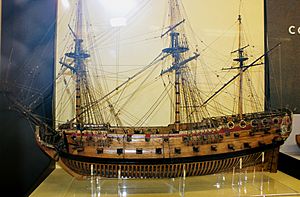HMS Dreadnought (1691) facts for kids
 |
|
Quick facts for kids History |
|
|---|---|
| Name | HMS Dreadnought |
| Builder | Johnson, Blackwall Yard |
| Launched | 1691 |
| Fate | Broken up, 1748 |
| General characteristics as built | |
| Class and type | 64-gun third rate ship of the line |
| Tons burthen | 852 |
| Length | 142 ft (43.3 m) (gundeck) |
| Beam | 36 ft 5.5 in (11.1 m) |
| Depth of hold | 17 ft 6 in (5.3 m) |
| Propulsion | Sails |
| Sail plan | Full-rigged ship |
| Armament | 64 guns of various weights of shot |
| General characteristics after 1706 rebuild | |
| Class and type | 60-gun fourth rate ship of the line |
| Tons burthen | 911 |
| Length | 142 ft 10.5 in (43.5 m) (gundeck) |
| Beam | 38 ft 1 in (11.6 m) |
| Depth of hold | 15 ft 9 in (4.8 m) |
| Propulsion | Sails |
| Sail plan | Full-rigged ship |
| Armament | 60 guns of various weights of shot |
HMS Dreadnought was a powerful warship from the past. She was a 64-gun third rate ship of the line for the Royal Navy. This means she was a large sailing ship with many cannons, designed to fight in naval battles.
She was built at a place called Blackwall Yard in 1691. Over her long life, Dreadnought changed quite a bit.
Contents
The Life of HMS Dreadnought
From Battle Ship to Hulk
When Dreadnought was first launched, she was a "third rate" ship. This was a way to classify warships based on their size and how many guns they carried. She had 64 guns ready for battle.
In 1697, her classification changed. She became a "fourth rate" ship. This usually meant she was slightly smaller or carried fewer guns than before.
Rebuilds and Changes
Dreadnought went through a major rebuild in 1706. This happened at the same shipyard where she was first built, Blackwall. After this rebuild, she became a 60-gun fourth rate ship.
Later, in 1722, the ship was made even larger. Ships were often rebuilt or enlarged to keep them useful or to update their design.
By 1740, Dreadnought's role changed again. She was converted into a "hulk." A hulk is an old ship that can no longer sail or fight. Instead, it's used for storage or as a floating barracks for sailors.
Dreadnought served as a hulk for eight more years. Finally, in 1748, she was "broken up." This means the ship was taken apart, and her useful materials were salvaged.
A Notable Captain
From 1716 to 1718, a man named Sir Tancred Robinson was the captain of HMS Dreadnought. Captains were very important leaders on these large warships.

